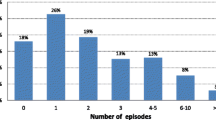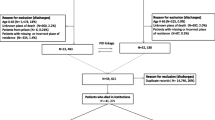Abstract
Aim
This study sheds light on the high cost of inpatient care of decedents in comparison to that of survivors, a less known aspect of out of pocket (OOP) healthcare cost in India. The main objective is to compare the differentials in OOP inpatient care expenditures of decedents and survivors and examine the significant correlates of inpatient care cost controlling for survival status.
Subject and methods
This study uses nationally representative unit level data from the 60th round (2004–2005) of the National Sample Survey on morbidity and healthcare. Descriptive statistics and bivariate analysis are employed to describe characteristics of inpatients and compare unadjusted mean OOP expenditures for care of inpatient decedents and survivors, between public and private health facilities. A multilevel hierarchical model is used to model OOP expenditures for inpatient care.
Results
The inpatient care cost of decedents is much higher than that of survivors. The differential is significantly higher for those residing in rural areas, staying longer in hospitals, utilizing private health facilities and suffering from non-communicable and other serious diseases. There is significant differential in OOP inpatient care cost between individuals and between episodes of hospitalization of individuals.
Conclusion
The findings of this study can be used to assess the economic burden of inpatient care induced by increasing life expectancy and epidemiological transition in India. Social security and other social assistance programs in India should be made sensitive to the high cost of inpatient care at the end of life. There is an urgent need to expand the outreach of the public health system in India to rural areas.



Similar content being viewed by others
References
Emanuel E, Fairelough DL, Slutsman J, Emanuel L (2000) Understanding economic and other burdens of terminal illness: the expenditure of parents and their caregivers. Ann Intern Med 132:451–459
Engelgau MM, Karan A, Mahal A (2012) The economic impact of non-communicable diseases on households in India. Glob Heal 89:1–10
Garg CC, Karan AK (2009) Reducing out-of-pocket expenditure to reduce rural poverty: a disaggregated analysis at rural–urban level in India. Health Policy Plann 24(2):116–128
Ginzberg E (1980) The high cost of dying. Inquiry 17:293–295
Hogan C, Lunney J, Gabel J, Lynn J (2001) Medicare beneficiaries’ costs of care in the last year of life. Health Aff 20(4):188–195
Ladusingh L, Pandey A (2013) Health expenditure and impoverishment in India. J Health Manag 15(1):57–74. doi:10.1177/0972063413486031
Lubitz JD, Riley GF (1993) Trends in medicare payment in the last year of life. N Engl J Med 328:1092–1096
National Sample Survey Organization (2004) Morbidity, healthcare and the condition of the aged. Report no. 507, Department of Statistics, Government of India, New Delhi
Payne G, Laporte A, Foot DK, Coyte PC (2009) Temporal trends in the relative cost of dying: evidence from Canada. Health Policy 90:270–276
Raphael C, Attens J, Fowlex N (2001) Financing end of life care in the USA. J R Soc Med 94:458–461
Scitovsky AA (2005) The high cost of dying: what do the data show? The Milbank Q 83(4):825–841
Seshamani M, Garg AM (2004a) Time to death and health expenditure: an improved model for the impact of demographic change on health care costs. Age Ageing 33:556–561
Seshamani M, Garg AM (2004b) A longitudinal study of the effects of age and time to death on hospital costs. J Health Econ 23:217–235
Singh CH, Ladusingh L (2010) Inpatient length of stay: a finite mixture modeling analysis. Eur J Health Econ 11(2):119–126
Stearns SC, Norton EC (2004) Time to include time to death? The future of health care expenditure. Health Econ 13(4):315–327
Sutton GF (1965) ‘Hospitalization in the last year of life, United States, 1961’. Vital and health statistics, Series 22(1), US Department of Health, Education and Welfare, Washington, DC
Werblow A, Felder S, Zweifel P (2005) Population aging and health care expenditure: a school of ‘red herring’. Working paper no. 11, Faculty of Economics and Management, Univ. of Magdeburg, Magdeburg, Germany
Zweifel P, Felder S, Werblow A (2004) Population aging and health care expenditure: new evidence on the red herring. Health Econ 8(6):485–496
Declaration of conflicting interests
The authors declare no potential conflict of interest with respect of the authorship and/or publication of this article. There is no ethical issue as the study is based on data available in the public domain.
Author information
Authors and Affiliations
Corresponding author
Appendix
Appendix
-
1.
Gastro-intestinal diseases include diarrhoea/dysentery, gastritis/gastric or peptic ulcer, worm infestation, amoebiosis, and hepatitis/jaundice.
-
2.
Febrile illness includes malaria, eruptive, mumps, diphtheria, whooping cough, and fever of unknown origin.
-
3.
Other communicable diseases include tetanus, filariasis/elephantiasis, and diseases of skin, gynaecological disorder, under-nutrition/anaemia, sexually transmitted disease, and respiratory (including ear/nose/throat) ailments for ages <15 years.
-
4.
Cardiovascular disease includes hypertension and heart attack.
-
5.
Other non-communicable diseases include disorders of joints and bones, psychiatric disorders, prostatic disorder, and respiratory (including ear/nose/throat) ailments for ages >15 years.
-
6.
Other diseases and disabilities includes goitre, eye ailments (cataract, glaucoma, conjunctivitis), diseases of the mouth, teeth and gums, disabilities, other diagnosed ailments, and other undiagnosed ailments.
-
7.
Other medical expenditures include diagnostic charges, bed charges, attendant charges, physiotherapy charges, and cost of personal medical appliances.
-
8.
Other charges under medical expenditure include expenditure on food and other materials, blood, oxygen cylinder, etc., services (ambulance etc.).
Rights and permissions
About this article
Cite this article
Ladusingh, L., Pandey, A. High inpatient care cost of dying in India. J Public Health 21, 435–443 (2013). https://doi.org/10.1007/s10389-013-0572-9
Received:
Accepted:
Published:
Issue Date:
DOI: https://doi.org/10.1007/s10389-013-0572-9




